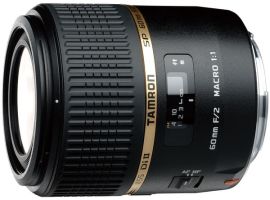We measured the Nikon version of the Nikon version of the Tamron SP AF 60mm F/2 Di II mounted on a Nikon D7000 body and its Canon version on a Canon 7D body. In both cases, the resolution is quite good and the lens showed a good homogeneity across the field from f/4 and above, especially the Nikon version. It is this measurement, by the way, that accounts for the difference in scores for these particular lens/camera combinations. It is worth noting that both scores are on the low side but at that price, it could be a good compromise.
All other image quality measurements were within acceptable limits, including those for distortion and transmission. As for vignetting, it’s more noticeable on the Nikon than the Canon at f/2 and f/2.8, but this said, it entirely disappears from f/4 onwards. The measurements for chromatic aberration were similarly negligible for both cameras.
Tamron AF 60mm F/2 Di II vs Canon EF-s 60mm F2.8 Macro USM
We then compared the Tamron AF 60mm F/2 Di II with the Canon EF-s 60mm F2.8 Macro USM lens (full results here), both mounted on a Canon 7D body. Again, the results for both lenses were disappointingly lower than expected (48 lp/mm). From f/5.6 to the highest shutter speed, their resolution profiles are identical; at f/2.8, however, the Canon lens shows better homogeneity.
Distortion and transmission are within acceptable limits. Vignetting for the Tamron at f/2 is comparable to vignetting for the Canon at f/2.8; for both lenses, vignetting disappears at f/5.6. (Note that this lens can be mounted on certain full-size camera bodies, in which case vignetting becomes very important, naturally enough.) Neither lens produced significant chromatic aberration.
Between the two competing lenses, the Canon has a slight edge over the Tamron, as the former achieves its maximal performance at f/2.8, while the latter achieves its best performance at f/4.
As for other performance criteria, here are a few points to be noted: Even if the manual focus ring feels a bit “stiff’ or “sticky,” the fact that you can manually focus this lens while still in auto-focus mode has won praise from macro-lens users across the board. This seems to have been a good design decision on Tamron’s part, since quite often the Tamron AF feature does not work very well when mounted on a Canon body.
Conclusion
Despite its being more expensive than many typical macro lenses (which start at f/2.8), it is clear that many macro aficianados have been completely charmed by Tamron’s ability to shoot at f/2, with virtually distortion-free performance at 1:1 macro distances as well as at “normal” shooting distances.





DXOMARK encourages its readers to share comments on the articles. To read or post comments, Disqus cookies are required. Change your Cookies Preferences and read more about our Comment Policy.